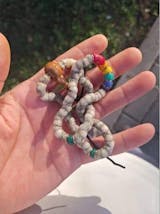Introduction
Dzi beads, often revered as mystical artifacts, hold a significant place in Tibetan culture. Their rich history, unique crafting process, and distinctive qualities make them highly sought after by collectors and spiritual practitioners alike. In this article, we will explore the evolution of Dzi beads, the intricate steps involved in their creation, and essential tips for identifying genuine beads.
The Evolution of Dzi Beads
The origins of Dzi beads can be traced back to ancient civilizations, particularly in the regions of Tibet and the Indian subcontinent. The earliest Dzi beads are believed to have appeared around 4,500 to 6,000 years ago during the Indus Valley Civilization. Known as "Bengal Dzi," these beads featured designs resembling tortoise shells, symbolizing longevity.
The term "Dzi" itself means "shine" or "brightness" in Tibetan, reflecting the beads' luminous appearance. Over the centuries, the craftsmanship of Dzi beads evolved, leading to the creation of various styles and patterns. During the Tang Dynasty (618–907 AD), Dzi beads became associated with Tibetan Buddhism, and their popularity soared as they were believed to possess protective and healing properties.
By the time of the Qing Dynasty, Dzi beads began to transition from sacred objects to decorative jewelry. Their significance continued to grow, and they became a status symbol among the Tibetan elite. Today, Dzi beads are not only cherished for their beauty but also revered for their spiritual attributes.
The Crafting Process of Dzi Beads
The creation of Dzi beads is a meticulous process that involves several key steps, showcasing the artisan's skill and dedication.
1.Shaping: Initially, the base material, often agate or other gemstones, is shaped into beads. The natural characteristics of the stone are preserved during this stage, ensuring that the bead retains its authentic qualities.
2.Bleaching: The beads are often subjected to a bleaching process, where they are immersed in a special dye to achieve a uniform color. This step conceals any natural patterns, creating a blank canvas for further design.
3.Designing: Using an anti-dye technique, artisans then paint intricate patterns on the bleached surface. The areas covered by the anti-dye agent will retain their whiteness, resulting in striking designs against the darkened background.
4.Dyeing: After the designs are applied, the beads undergo a second dyeing process using alkaline solutions, which creates a contrast between the painted designs and the bead's surface.
5.Firing: The beads are then carefully dried and fired, a process that helps to set the colors and enhance their durability.
6.Polishing: Finally, the beads are polished to achieve a smooth, lustrous finish, showcasing their vibrant colors and intricate designs.
This extensive craftsmanship reflects the deep cultural significance and value attributed to Dzi beads.
Identifying Genuine Dzi Beads
When it comes to purchasing Dzi beads, discerning authenticity is crucial. Here are some tips to help identify genuine Dzi beads:
Surface Quality: Authentic Dzi beads should have a smooth, oily texture and a waxy luster. Look for evenly distributed red cinnabar dots; irregular dots may indicate fakes.
Color Depth: Quality beads will have vibrant, consistent colors and lively patterns. Avoid beads with flat or dull colors.
Hole Quality: Examine the holes; older Dzi beads should show natural wear. If the edges are sharp, the bead is likely new or untested.
Weathering Patterns: Genuine aging is indicated by irregular, semi-circular patterns. Uniform patterns suggest machine manufacturing, which lacks the charm of authentic Dzi beads.
By familiarizing yourself with these characteristics, you can appreciate the value and meaning behind each Dzi beads bracelet or other accessories you wear.
Conclusion
Dzi beads encapsulate a rich history, exquisite craftsmanship, and cultural reverence. As you explore the world of Dzi beads, understanding their evolution, production process, and identification will enhance your appreciation for these remarkable artifacts. Whether you seek them for their beauty, spiritual significance, or as collector's items, Dzi beads remain timeless treasures that continue to inspire and captivate.
Related articles:
What are Dzi Beads
Can I Wear Dzi Beads to Sleep?
Explore The Tibetan Nine-Eye Dzi Beads
























